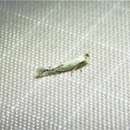Comprehensive Description
provided by Memoirs of the American Entomological Society
Bucculatrix longula new species (Figs68, 68a, 69, 69a.)
Head white, tuft with ocherous and brown hairs; antennal stalk whitish at base, shading outwardly to pale brownish and indistinctly annulate ; antennal notch of male slight. Thorax white, tegulae anteriorly faintly yellowish. Fore
wings shining white, with pale ocherous marks, some of which may be faint or absent ; from base along fold to two-fifths the wing length, a slender ocherous streak; a second longitudinal streak in the cell, arising just basad of the end of the first, extends nearly to the end of the cell ; from three-fifths of costa, a narrow straight line of pale ocherous scales extends diagonally across the wing to tornus, at its costal end and at end of cell the scales are dark-tipped, at tornus meeting a larger group of more conspicuously dark brown-tipped scales ; on costa midway between this diagonal line and apex, a group of pale ocherous narrowly dark-tipped scales ; on middle of dorsum a pale ocherous oblique spot, bearing a group of blackish-tipped raised scales, sometimes the most conspicuous mark on the wing ; from the group of dark-tipped scales at tornus, a line of dark-tipped scales along termen to apex ; a second line of scales in the cilia, their dark tips lying near to and nearly parallel to the terminal row (less than one-third the length of the cilia from their bases) meets it at apex; cilia white. Hind wings and cilia white, faintly ocherous tinged. Legs ocherous, tarsal segments, especially of the fore and middle legs dark-tipped. Abdomen ocherous, grayish in the male.
Alar expanse 12 to 12.5 mm.
Male genitalia (figs. 68, 68a). Harpes nearly parallel-sided, apical area with short heavy conical setae ; socii long, densely clothed with very long fine setae; membrane ventrad of the alimentary canal microscopically spinulose; anellus a slender cone ; aedeagus long, tapering to slender apex, a pair of opposing teeth near mouth. Scale sac large, numerous small scales.
Female genitalia (figs. 69, 69a). Ostium goblet-shaped, microscopically spinulose; ductus bursae forked in segment 6 just before entering bursa; signum ribs variously spined, posteriorly usually one or more heavy spines, sometimes branched, grading to short or slender spines.
Type. — $, Wilma, Whitman Co., Washington, 24.1 V. 34, reared from Helianthus annuus L. (J. F. G. Clarke) [U.S.N.M., Type No. 65014].
Allotype. — ?, same data as the type, except date of emergence 29. IV. 34 Paratypcs.—Z $ , 4 2 , Wilma, Whitman Co., Washington, April 14 to 29, 1934; 1 $, Snake River, Whitman Co., Washington, 25.V.34; 1 $, Almota, Washington, 26.IV.34, all reared from Helianthus annuus L. (J. F. G. Clarke) [U.S.N.M.]; 1 ?, Salt Lake. Utah, Jl. 18, 13, "from gall on Helianthus" (Timberlake Coll.) [U.S.N.M.].
The type series was reared from stem galls on Helianthus annuus L. The type and allotype display clearly all the marks mentioned in the description ; in some specimens these marks are faint or obsolete.
The approximate and nearly parallel lines of dark-tipped scales along termen, the second near bases of the cilia, are distinctive of this species and also serve to separate it from the closely allied B. simulans new species, and from B. niveella Chambers. The fore wings are also more acute than in that species, and the whole aspect is different. The long slender aedeagus (checked by a second slide) of this species contrasts with the short wide-mouthed aedeagus of B. simulans. The very long, fine setae clothing the socii are characteristic of both B. longida and B. simulans and occur in no other species.
- bibliographic citation
- Braun, A.F. 1963. The Genus Bucculatrix in America North of Mexico (Microlepidoptera). Memoirs of the American Entomological Society vol. 18. Philadelphia, USA
Bucculatrix longula: Brief Summary
provided by wikipedia EN
Bucculatrix longula is a moth in the family Bucculatricidae. It was described by Annette Frances Braun in 1963. It is found in North America, where it has been recorded from California, Texas, Washington and Utah.
The larvae feed on Helianthus annuus. They create a stem gall.
- license
- cc-by-sa-3.0
- copyright
- Wikipedia authors and editors

